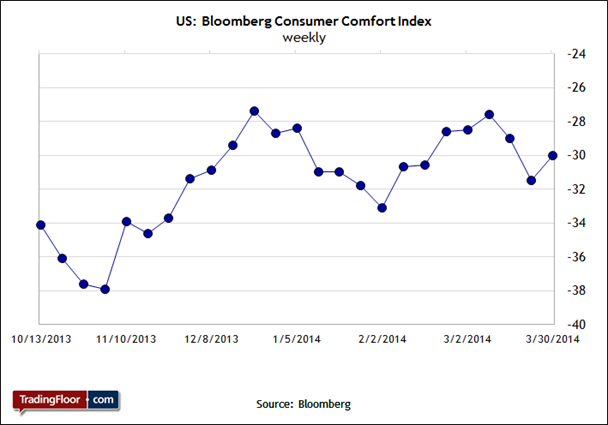•ECB keeps cautious stance over monetary policy
• Eurozone economic growth still weak
• US data suggests spring thaw after retail spending rise
Thursday is a busy day for economic releases, including a new monthly report from the European Central Bank (ECB) that will be closely read as the market looks for fresh clues about the outlook for changes in monetary policy. Later, we’ll see new US data via initial jobless claims and the Bloomberg Consumer Comfort Index. Meanwhile, don’t overlook other releases, such as updates on industrial production for France (06.45 GMT) and Italy (08.00 GMT) and an interest rate announcement from the Bank of England (11.00 GMT).
European Central Bank Monthly Bulletin (08.00 GMT)
Headline inflation is low and decelerating while Eurozone economic growth outside Germany is still weak to non-existent. The case for doing more with monetary policy, in short, remains compelling. Meantime, the risk of unleashing high inflation any time soon is low to nil. But the ever cautious ECB prefers to wait. The rationale rests, in part, on the fact that so-called core inflation has remained steady. By contrast, headline inflation, which includes the most volatile prices such as energy and food, has been slipping again. This suggests that the risk of deflation is rising. In fact, both core and headline inflation rates on a year-over-year basis are unusually low i.e 0.8 percent for core, 0.5 percent for headline through last month.
Regardless of whether the trend is stable or not, both measures of pricing pressures are well below the ECB’s 2.0 percent target and therefore the macro outlook remains compromised. As The Economist reminded us this week: "there is still a concern that the recovery may have come too late and be too weak to avert the onset of deflation".
Does this make a strong case for more action on the ECB’s part? It’s easy to find analysts who answer with a resounding “yes”. However, the central bank is sticking with the status quo although the bank recently hinted at the possibility of rolling out its own brand of quantitative easing to juice economic activity and lift inflation. It’s a mistake, however, to assume that fresh ECB action is imminent, or so we’re told by a member of the bank’s Executive Board. "From the theoretical agreement to the implementation of the operations is still a long way," he advised this week via Reuters. Indeed, there are some technical hurdles to overcome, as Bloomberg recently explained: “Mario Draghi’s asset-purchase plan to ward off deflation may be lacking one key element: enough assets to buy.”
Nonetheless, today’s monthly report from the ECB deserves close attention for any clues on the timing and/or the details of a policy evolution. “The [European Central Bank] could do a little bit more,” said the IMF’s chief economist, Olivier Blanchard: “My understanding is that they are thinking very hard, they just want to do it right.” What does “right” mean? Today’s release may provide an answer.
US Initial Jobless Claims (12.30 GMT)
The latest batch of numbers on the US economy suggests that the optimists are right and that a spring thaw is underway. Retail spending is picking up, according to data this week from Redbook and the International Council of Shopping Centers. Meanwhile, the number of job openings is trending higher again, according to the government’s so-called JOLTS report (Job Openings and Labour Turnover Survey). The news follows last week’s upbeat numbers on manufacturing and services sectors via surveys from the Institute for Supply Management. In addition, the March non-farm payrolls report reflects a stronger rate of growth.
Economists believe we’ll see more progress in today’s update on weekly jobless filings. The consensus forecast calls for a modest decline from 326,000 to 318,000 in the previous report. In that case, this key leading indicator will strengthen the case for thinking that the US economy’s modest growth may accelerate. The IMF expects as much. “Monetary policy in the United States has begun to return to normal amid growing signs that the country’s economic recovery is gaining traction,” the Fund noted this week.
Today’s jobless claims data looks poised to reinforce this view.

Shortly after today’s jobless claims numbers arrive we shall have another update on the mood among consumers. The possibility of two back-to-back encouraging macro reports can’t be dismissed. Although sentiment on Main Street has been relatively lacklustre lately, this benchmark from Bloomberg is hinting at the possibility of a spring revival.
In last week’s release, the Consumer Comfort Index (CCI) increased after touching its lowest level since early February. “The emergence of job security, illustrated by a slower pace of firings, appears to have trumped rising gasoline prices and the lagged effect of lost work hours during a very difficult winter,” according to an economist at Bloomberg. “Should this improvement in sentiment and consumer expectations continue, it bodes well for real personal consumption.”
Indeed, if jobless claims fall and CCI rises, optimism should perk up for expecting that next week’s monthly retail sales report for March will add to the growing case for thinking positively about the US macro trend.

